When a historic brand dares to use turquoise on a 1930s medical chronograph, the result can be surprising. Between a centuries-old watchmaking heritage and chromatic audacity, the Vulcain Monopusher Heritage shakes up the codes of neo-vintage with a surprisingly modern proposition.
What if I told you that a chronograph designed to take a pulse could become one of the most desirable watches of 2024?
Forget everything you think you know about vintage chronographs. Most enthusiasts will tell you that a beautiful retro watch should remain sober, discreet, in classic tones. Wrong. The Vulcain Monopusher Heritage Turquoise shatters this convention with refreshing audacity: imagine a medical instrument from the 1940s dipped in the crystal-clear waters of a tropical lagoon.
A single button. An impossible color. 39.2 millimeters of pure watchmaking provocation.
This watch shouldn’t work. A sunburst turquoise dial on a pulsometer chronograph? A “Graduated for 30 pulsations” scale on a fashion piece? Yet, Vulcain transforms this apparent contradiction into a neo-vintage masterpiece.
The Le Locle-based brand, founded in 1858, proves that you can respect history while reinventing it. Get ready to discover why this limited edition is making savvy collectors tremble…
Sommaire
Analysis of the Vulcain Monopusher Heritage Turquoise Chronograph
Introduction & Historical Context
The Vulcain Monopusher Heritage Turquoise chronograph embodies the meeting of a rich watchmaking heritage and a resolutely neo-vintage aesthetic. Launched as a limited edition, this timepiece is inspired by the monopusher chronographs of the 1930s-1950s from the house of Vulcain. To understand its appeal, one must go back to its origins: Vulcain, founded in 1858, was already innovating in 1934 with single-pusher chronographs, notably the caliber 292 and the rare Y65 movement.
These watches were used by both enthusiasts – it is said that a Vulcain timed Real Madrid’s training sessions in 1934 – and by armed forces (the Uruguayan army reportedly used a monopusher pulsometer model). Today, the brand is reviving this tradition by adapting its historical style to contemporary tastes. Thus, the “Heritage Turquoise” model draws its character from the codes of sports chronographs from the first half of the 20th century, while adding a touch of bold modernity: a vibrant turquoise dial with a retro-futuristic charm.
In the 1930s, monopusher chronographs represented the ultimate sports instrument: a single button to start, stop, and reset the chrono, a guarantee of simplicity and efficiency. Vulcain was among the pioneers of this complication, with elegant and slim watches equipped with telemetric or pulsometric scales. The period inscription “Gradué pour 30 pulsations” on the edge of the dial testifies to this, allowing doctors to measure the pulse over 30 beats.
This detail is proudly featured on the new Turquoise edition, a testament to the brand’s fidelity to its roots.
Vulcain’s neo-vintage comeback since 2022 is part of this lineage: the Le Locle-based company is resurrecting its historic models (one also thinks of its aviator watches and its famous Cricket alarms) by subtly modernizing them. In 2023, Vulcain introduced the Monopusher Heritage in a 39 mm format, initially available in black, “black & white” (reverse panda), and salmon dial versions (limited series of 50 pieces).
Building on the success of these editions, the brand expanded the palette in 2024 with bold shades like a lime green and especially this magnificent sunburst turquoise. This unexpected “Blue Lagoon” color choice brings a breath of stylistic fresh air, where many vintage chronographs are confined to sober tones or classic panda dials. The Monopusher Turquoise immediately catches the eye: its hue evokes the clear waters of tropical lagoons and gives the watch a playful and refreshing personality, while contrasting with the seriousness of its retro design.
Design, Dial & Neo-Vintage Elements
With a diameter of 39.2 mm and a contained thickness (~13.4 mm), the 316L steel case of the Monopusher Turquoise respects the compact proportions of vintage watches. We find a “case middle” with polished flanks and finely brushed, faceted lugs, evoking the cases of the 1950s. The smooth bezel and the “double dome” sapphire crystal with anti-reflective treatment reproduce the look of domed plexiglass of yesteryear, offering superb optical distortions on the periphery of the dial. The latter is undoubtedly the centerpiece: its sunburst turquoise finish plays with the light, shifting from electric light blue reflections to softer hues depending on the angle.
This bold color choice hits the mark – it gives a youthful touch to the vintage look, as if a 1940s medical watch had taken a sunbath in Capri in the 60s! Vulcain has kept the painted Arabic numerals and the elegant “leaf” hands for the hours and minutes. The chronograph adopts a symmetrical Bicompax configuration: small seconds counter at 9 o’clock, 30-minute totalizer at 3 o’clock. The azuré subdials in a tone-on-tone turquoise remain discreet, highlighting the overall clean impression of the dial.
Dial Focus: A Closer Look at the Guilloché Sub-dials and the “Railway” Track
Let’s (finally) dive into the details that bring this turquoise dial to life:
- Guilloché Sub-dials (3 o’clock & 9 o’clock)
– Each is slightly recessed (≈ 0.25 mm) into the main plate; this step creates a sharp shadow that accentuates the depth.
– The surface is not smooth: Vulcain has opted for a circular guilloché known as “azuré” — a succession of concentric grooves of about 0.05 mm, obtained by CNC milling followed by very light polishing.
– The turquoise appears, here, half a tone darker due to the topography; a nice play of contrast that facilitates reading without resorting to different colors.
- Peripheral Railway Track and Central Link
– The minutes/seconds rail-track is printed in extremely fine black lacquer; its half-second (short lines) and full-second (long lines) segmentations measure approximately ≈ 0.13 mm and ≈ 0.25 mm in thickness, respectively.
– A special feature: it forms a visual 8 by “crossing” the sub-dials. Vulcain has not interrupted the railway track; the decoration runs along the slope of the flange, glides over the edge of each sub-dial, then re-emerges to complete the minute track. This continuous ribbon is reminiscent of 1940s medical chronographs: a historical nod as much as a visual cue.
– In grazing light, the glossy black varnish contrasts with the satin turquoise paint; this dark accent emphasizes the bicompax symmetry, while guiding the eye to the central chronograph hand.
- Light-Texture Interaction
– At a sharp angle, the concentric guilloché diffuses light in “waves” while the flatter railway track reflects it like a mirror; the result is a light signature with two rhythms.
– Reading becomes intuitive: one can instantly spot the 30 minutes on the right counter thanks to the dance of the grooves, and follow the central second hand along the rail without losing track of the pulsations.

In short, these micro-textures are not just aesthetic: they orchestrate readability and extend the model’s medical-sports DNA. The sub-dials are reminiscent of a stethoscope’s magnifying glass, the railway track evokes the rigor of an ECG. So many details that make this turquoise dial a small watchmaking playground, where each ray of light tells a different story.
Another vintage nod: the outer flange carries the bilingual pulsometer scale, just like on the post-war Vulcain models intended for medical personnel. Also noteworthy is the retro font of the Vulcain logo at 12 o’clock, as well as the complete absence of a date (to preserve the authenticity of the design). The single chronograph pusher is positioned at 2 o’clock, above the screwed-down fluted crown at 3 o’clock – a typical arrangement for historical monopushers, here perfectly integrated into the case.
Despite its deliciously old-school style, this watch is suitable for daily wear thanks to contemporary specifications: scratch-resistant sapphire crystal, luminescence on the hands, and a water resistance of 50 m (5 ATM), sufficient for everyday life. Although we would have preferred 100 m to be completely at ease, let’s remember that the watch’s purpose is more automotive and urban than deep-sea diving.
The solid, screwed-down case back is engraved with the Vulcain coat of arms and a proud inscription “SOLD THE WORLD OVER SINCE 1858”. This is probably the least exciting design element, but it has the merit of being consistent with older watches.
Vulcain offers a wide choice of 20 mm straps to accompany this model: from classic black or brown leather, an original gray leather, a seductive vintage “rice grain” steel bracelet, as well as a racing-style tropic rubber strap. The fit on the wrist is excellent: thanks to the moderate lug-to-lug measurement (~47 mm), the watch fits medium wrists well. We also appreciate the smoothness of the single pusher – a often dreaded technical element. Here, Vulcain has taken care of the mechanism: the Start/Stop/Reset commands are performed with a pleasant progressiveness, without excessive effort.
Sellita SW510 M MP b Movement & Performance
Under the hood, the caliber SW510 M MP b ensures reliability and ease of maintenance. It is a manual-winding mechanical chronograph movement, produced by Sellita. This choice is wise: it allows for a complicated watch to be offered at a reasonable price, while providing modern performance. The SW510 M MP runs at 4 Hz (28,800 vph) and offers approximately 60 hours of power reserve – enough to last more than two days without winding.
Its column wheel design ensures a clean engagement of the chronograph functions. Enthusiasts will note that this is not a Vulcain manufacture caliber, but the compromise is acceptable, especially since other prestigious brands use exactly this movement for their own much more expensive monopushers.
Regarding regulation and precision, our example was well-adjusted out of the box, with a deviation of about +8 seconds/day, which is within the average tolerances for this movement. The manual winding is smooth, providing that tactile pleasure of a direct connection with the movement – a plus for purists. The choice of a manual movement also helped to limit the thickness of the watch, enhancing its vintage charm. The only minor drawback could be the lack of a flyback function – unnecessary for most users, but a competitor like the Longines Spirit Flyback offers it for a higher price.
Strengths & Weaknesses: User Feedback
After several months on specialized forums, the Vulcain Monopusher Heritage has garnered overall very positive reviews. Among the frequently cited strengths is, first and foremost, the quality of execution of the whole package: the watch gives an impression of solidity and care. The alternations of polished and brushed surfaces are sharp, and the turquoise dial has won over more than one collector.
Many praise the “authentic retro charm” of this model. The single pusher is also unanimously praised: its smooth operation is a pleasant surprise, encouraging regular use.
On the weaknesses side, the limited water resistance of 50 m has made some hesitate. Secondly, the brand’s limited distribution has been mentioned: with few retailers, it is not easy to try the watch before buying. However, since the heart of the movement is a mass-produced one (Sellita SW510), any out-of-warranty work can be performed by a competent watchmaker. In reality, the sensitive point is rather that production volumes are low, which caused temporary stock shortages just after its launch.
Finally, some discerning collectors would have liked a more noble movement or a sapphire case back – but that would have sent the price soaring. In summary, user feedback confirms that the Monopusher Heritage fulfills its role: to offer an authentic watchmaking experience with contemporary reliability. Its main “flaw” is perhaps being a niche watch, which requires a certain historical sensitivity. But that is precisely its whole appeal.
Comparisons & Value for Money
Priced at around €2,950, the Vulcain Monopusher Heritage Turquoise is positioned in an interesting mid-range segment. Let’s compare it to some alternatives:
- Hamilton Intra-Matic Chronograph H (~€2,200): Manual bicompax chrono, successful look but less exclusive than Vulcain and slightly lower finishing.
- Baltic Bicompax 001 Pulso (~€700): Micro-brand with retro charm, but a less robust Chinese movement and simpler finishes.
- Longines Spirit Chronograph Flyback (~€4,500): A more high-end proposition with a flyback function, but significantly more expensive and larger.
- Yema Rallygraf Meca-Quartz (~€300): Very fun and affordable, but it’s a meca-quartz movement, so not the same mechanical “soul”.
- Seagull 1963 (~€300): The legendary Chinese chrono, very affordable but with sometimes inconsistent quality. The Vulcain plays in a much higher league.
In this landscape, the Vulcain Monopusher Heritage stands out for its positioning as a “small-batch, affordable high-end” piece. It costs significantly more than a Baltic or a Seagull, while remaining well below the monopusher chronographs of major houses. The Montblanc 1858 Monopusher (same movement, sold for around €5,000) illustrates that Vulcain offers a more exclusive alternative at a lower price. Vulcain remains a gem for connoisseurs, and that’s precisely what’s appealing: having a watch that you will almost never come across.
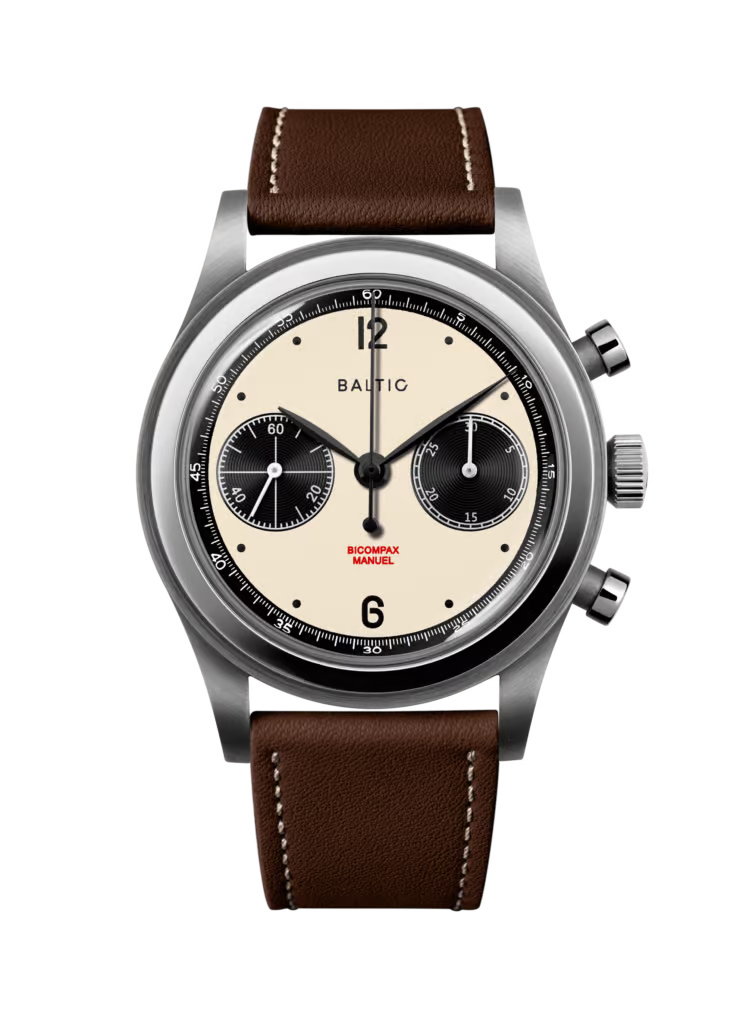
In terms of brand image, Vulcain appeals to a discerning audience in search of authenticity. Acquiring a Vulcain Monopusher is a way of showing that one knows watchmaking beyond the obvious. The question of value retention arises: as a relatively limited series, it is highly likely that these watches will maintain a stable value. In the long term, if Vulcain intelligently pursues its revival, these first neo-vintage editions could well become sought-after.
Verdict: Who is the Monopusher Turquoise for?
In conclusion, the Vulcain Monopusher Heritage Turquoise succeeds in a daring gamble: reinventing the retro chronograph by injecting a good dose of emotion into it. Its historical fidelity is exemplary, and yet, it manages to be furiously current and endearing. The turquoise brings joy and originality, without ever detracting from its elegance. It is a watch that is bought as much with the head (serious construction, reliable movement, 39 mm format) as with the heart (aesthetic pleasure, exclusivity, heritage).
What kind of buyer? Undoubtedly the enlightened vintage watch enthusiast who wants something different. The healthcare professional will see a nod with the pulsometer scale. It is not the typical “first purchase” watch, but rather the impulse buy piece. Beyond the color, it is the sum of its qualities that makes this Monopusher Heritage a success: a concentrate of watchmaking history, vintage emotion, and modern know-how, all at a still accessible price.
Style Tips
Outfit 1: Neo-vintage audacity at Pitti Uomo
The tobacco linen suit creates a striking thermal contrast with the turquoise dial. The warm tones of the brown oppose the aquatic coolness, generating a visual dynamic characteristic of the Pitti style.
The matte texture of the linen highlights the sunburst finish of the dial through contrast. The anthracite gray strap provides the neutral link between these two chromatic poles. This combination illustrates how a colored watch can modernize a classic silhouette without denaturing it.


Black Tie Attire
The combination of a tuxedo and a colored chronograph is a bold style exercise. The watch introduces an element of personalization into the most codified dress code there is.
The turquoise dial creates a discreet dialogue with the white shirt bib, subtly enlivening the sobriety of the tuxedo. The contained dimensions (39.2mm) allow for comfortable wear under the cuff. This configuration demonstrates that a distinctive timepiece can be integrated into an ultra-formal context with the right dosage.

Outfit 3: Celadon green and turquoise blue
The celadon green suit and the turquoise dial belong to the same family of cool tones, creating a natural visual continuity. The blue floral tie serves as a chromatic transition, while the white shirt provides the necessary breathing space for the ensemble.
The anthracite gray leather strap neutralizes the chromatic boldness, avoiding any risk of visual overload. This configuration demonstrates that a colored watch can be integrated into a formal outfit without looking out of place.



Buying Advice & Conclusion
If you are considering a purchase, a few practical tips are in order. Be sure to go through an official channel to benefit from the 2-year warranty. Inspect the operation of the monopusher and the accuracy. Avoid manipulating the pusher under water. As for maintenance, a full service is recommended every 5 to 7 years by Vulcain or an authorized Sellita watchmaker.
With the Monopusher Turquoise, Vulcain has not only resurrected a model from the past, but has also injected freshness into the collection of neo-vintage chronographs. Its value for money is very fair. Ultimately, to wear this chronograph is to wear a living piece of watchmaking history. For the enthusiast looking for a different, authentic piece with a design as charming as it is original, the Vulcain Monopusher Heritage Turquoise is an ideal candidate. There is no doubt that with this model, Vulcain has created a future collector’s classic. In short, a chronograph that is both serious in its heritage and light in its spirit.

